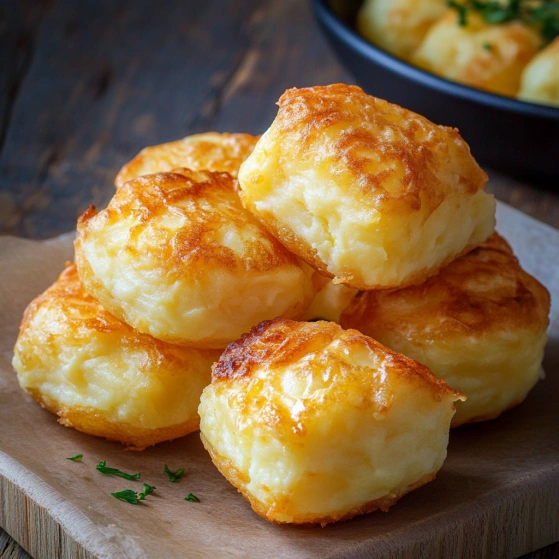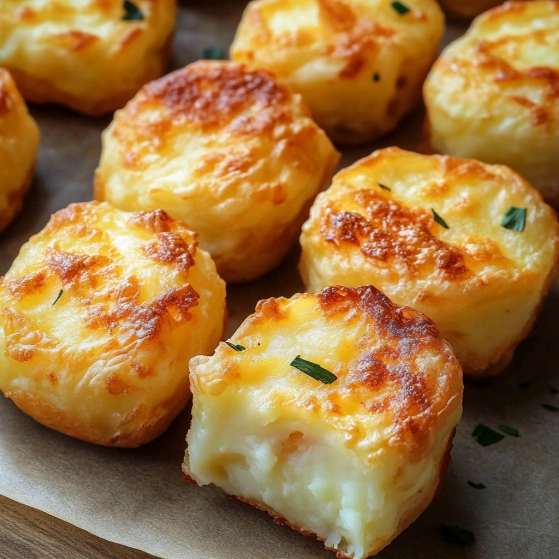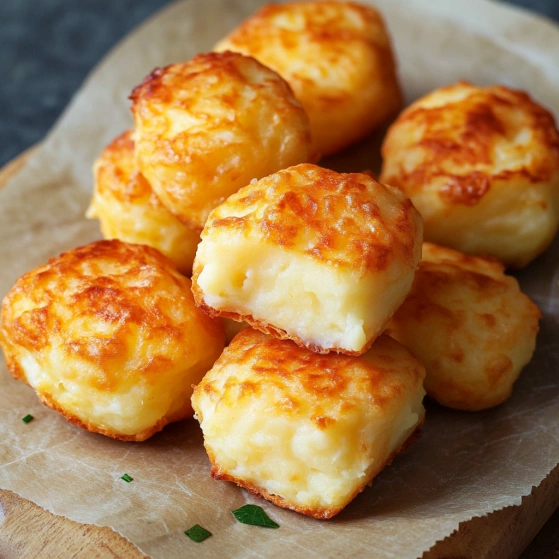 Pin it
Pin it
This creamy, cheesy mashed potato puffs recipe transforms leftover mashed potatoes into delightful, golden bites perfect for breakfast, snacks, or dinner sides. These savory treats combine the comfort of mashed potatoes with melty cheese and fresh herbs for an irresistible flavor explosion.
I first made these puffs after Thanksgiving when faced with a mountain of leftover mashed potatoes. My family devoured them so quickly that now I intentionally make extra mashed potatoes just for this recipe.
Ingredients
- Cold leftover mashed potatoes: Provide the perfect base and work better than freshly made hot potatoes
- Shredded cheese: Adds gooey, melty texture opt for sharp cheddar for extra flavor punch
- All purpose flour: Helps bind the mixture ensuring your puffs hold their shape
- Parmesan cheese: Creates a savory crust and depth of flavor
- Fresh chives: Add bright color and mild onion flavor use fresh for best results
- Sour cream: Contributes tangy creaminess and helps bind ingredients
- Eggs: Act as the essential binding agent that makes these puffs rise beautifully
Step-by-Step Instructions
- Prepare Your Oven:
- Preheat your oven to 400°F and thoroughly grease a standard muffin tin, making sure to coat sides and bottom completely to prevent sticking. Allow the oven to fully preheat for at least 10 minutes for even cooking.
- Create The Wet Base:
- In a large mixing bowl, thoroughly beat the eggs until frothy, then fold in the sour cream until completely smooth with no white streaks. This creates the moisture and richness foundation for your puffs.
- Add Flavor Elements:
- Incorporate the shredded cheese, Parmesan, and chives into your egg mixture, stirring until evenly distributed. Add a pinch of salt, adjusting to taste based on how seasoned your leftover mashed potatoes already are.
- Incorporate Potatoes:
- Gently fold the cold mashed potatoes into the mixture using a rubber spatula with a light hand. Overmixing will make your puffs dense, so stop folding once the mixture looks uniform but still has some texture.
- Fill And Bake:
- Spoon the potato mixture into your prepared muffin tin, filling each cup completely to the top. Slightly dome the tops for aesthetic appeal. Bake for 20 to 25 minutes, watching carefully for golden brown tops and puffed centers.
 Pin it
Pin it
The fresh chives are my secret weapon in this recipe. My grandmother always said green herbs make potato dishes come alive, and she was right. The first time I served these at a family brunch, my usually picky nephew asked for the recipe these became his first independent cooking project.
Make Ahead Options
These potato puffs excel as a make ahead dish. You can prepare the entire mixture up to 24 hours before baking and store it covered in the refrigerator. Simply bring the mixture closer to room temperature for about 15 minutes before baking. Alternatively, bake the puffs completely, cool them, and refrigerate for up to 3 days. Reheat in a 350°F oven for 10 minutes until warmed through and crisp again.
Flavor Variations
The basic recipe provides an excellent canvas for customization. Try adding cooked and crumbled bacon for a smoky element, or fold in caramelized onions for sweet depth. Experiment with cheese varieties Swiss creates a nutty profile, while pepper jack adds pleasant heat. For herb lovers, rosemary, thyme, or dill can replace or complement the chives. Remember that stronger flavored additions like blue cheese or roasted garlic should be used more sparingly.
 Pin it
Pin it
Serving Suggestions
These versatile puffs pair beautifully with so many meals. Serve them alongside a simple green salad for lunch, or with roasted chicken for dinner. For brunch, top with a poached egg and hollandaise for an elevated experience. They make excellent party appetizers when made in mini muffin tins and served with a dollop of sour cream and chive garnish. During cooler months, they complement hearty soups and stews remarkably well.
Troubleshooting Tips
If your puffs seem too wet, incorporating 1 to 2 additional tablespoons of flour can help absorb excess moisture. Conversely, if the mixture appears too dry or stiff, add an extra tablespoon of sour cream. For maximum rise, ensure your baking powder is fresh typically needs replacing after six months. If your puffs collapse after baking, you may need to bake slightly longer next time the centers should be completely set.
Frequently Asked Questions
- → Can I use different types of cheese in these potato puffs?
Absolutely! While the base recipe calls for cheddar or mozzarella, you can use any good melting cheese you prefer. Gruyère, Colby Jack, Monterey Jack, or even pepper jack for a spicy kick would all work wonderfully.
- → How should I store leftover potato cheese puffs?
Store cooled puffs in an airtight container in the refrigerator for up to 3 days. To reheat, place them in a 350°F oven for 5-10 minutes until warmed through. Avoid microwaving if possible, as it can make them soggy.
- → Can I freeze these potato cheese puffs?
Yes, they freeze well! Allow them to cool completely, then place in a single layer on a baking sheet to freeze. Once frozen, transfer to a freezer bag or container. Reheat from frozen in a 375°F oven for about 15 minutes.
- → What can I serve with mashed potato cheese puffs?
These versatile puffs pair wonderfully with a variety of accompaniments. Serve them as appetizers with sour cream, chive dip, or ranch dressing. As a side dish, they complement roasted meats, grilled chicken, or a fresh salad. They're also delicious for brunch alongside eggs.
- → Can I add other ingredients to the potato puff mixture?
Definitely! These puffs are very adaptable. Consider adding crumbled bacon, caramelized onions, roasted garlic, chopped herbs like parsley or dill, or even diced jalapeños for heat. Just be careful not to add too many wet ingredients, which could prevent proper puffing.
- → What if my mashed potatoes are already heavily seasoned?
If your leftover mashed potatoes are already well-seasoned or contain additional ingredients like garlic or herbs, simply adjust the seasonings in this recipe accordingly. You might want to reduce or omit the salt, depending on how seasoned your potatoes are.
